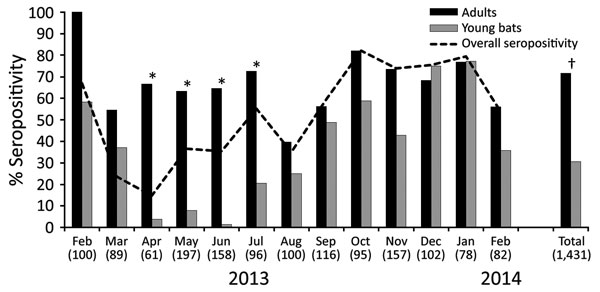Marburg Virus Infection in Egyptian Rousette Bats, South Africa, 2013–20141
Janusz T. Pawęska

, Petrus Jansen van Vuren, Alan Kemp, Nadia Storm, Antoinette A. Grobbelaar, Michael R. Wiley, Gustavo Palacios, and Wanda Markotter
Author affiliations: National Institute for Communicable Diseases of the National Health Laboratory Service, Johannesburg, South Africa (J.T. Pawęska, P. Jansen van Vuren, A. Kemp, N. Storm, A.A. Grobbelaar); University of Pretoria, Pretoria, South Africa (J.T. Pawęska, P. Jansen van Vuren, N. Storm, W. Markotter); University of Nebraska Medical Center, Omaha, Nebraska, USA (M.R. Wiley); US Army Medical Research Institute of Infectious Diseases, Frederick, Maryland, USA (M.R. Wiley, G. Palacios)
Main Article
Figure 1

Figure 1. Marburg virus seropositivity in Egyptian rousette bats in Matlapitsi Cave, Limpopo Province, South Africa, 2013–2014. Numbers in parentheses indicate number of bats sampled per month. Bats <1 year of age (young bats) represent the new generation of bats born mostly during the October–January birthing peak. Statistically significant differences in seropositivity between adult and young bats are noted over a period of 4 months, April–July 2013. *Significant difference (p = 0.0001) between adult and young bat populations. †Significant difference (p = 0.002) between adult and young bat populations.
Main Article
Page created: May 17, 2018
Page updated: May 17, 2018
Page reviewed: May 17, 2018
The conclusions, findings, and opinions expressed by authors contributing to this journal do not necessarily reflect the official position of the U.S. Department of Health and Human Services, the Public Health Service, the Centers for Disease Control and Prevention, or the authors' affiliated institutions. Use of trade names is for identification only and does not imply endorsement by any of the groups named above.
